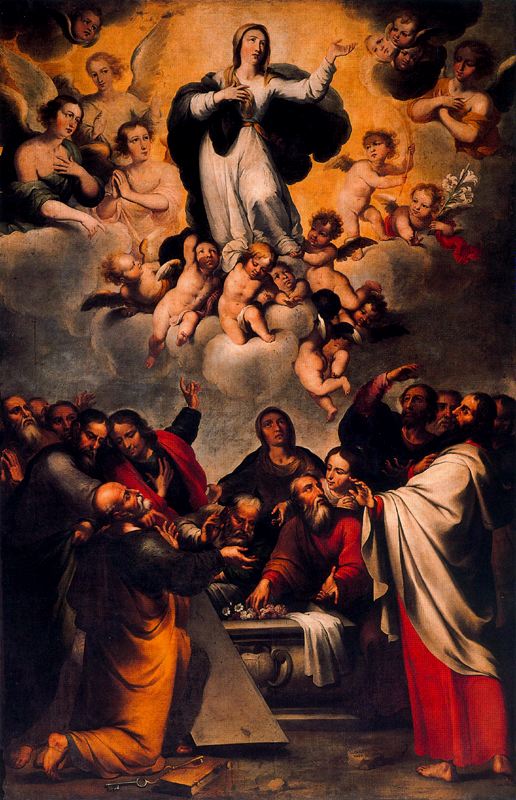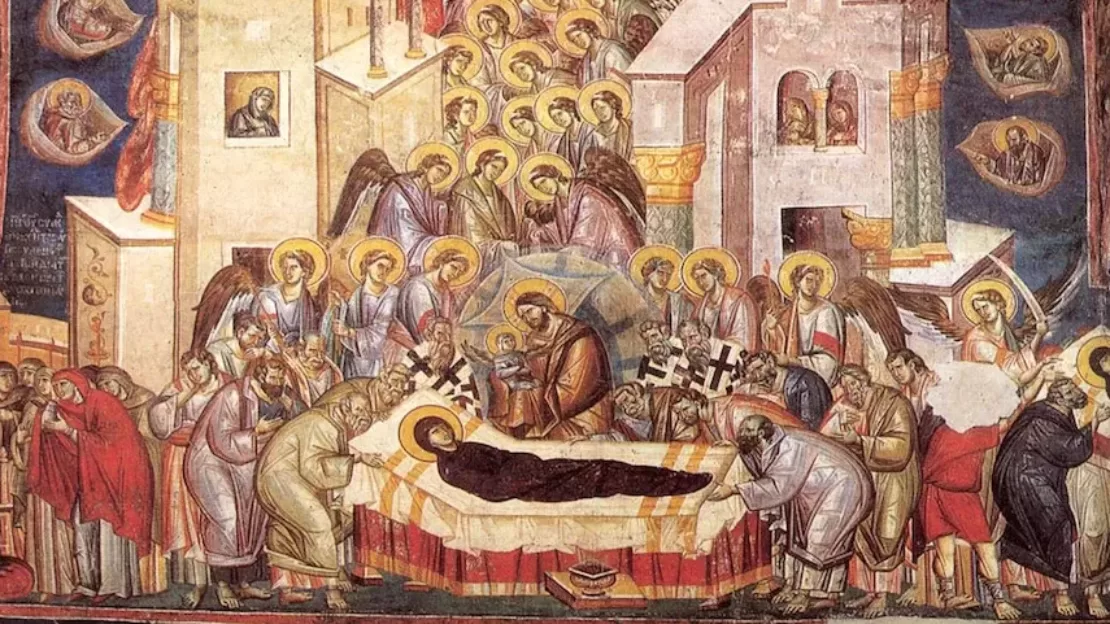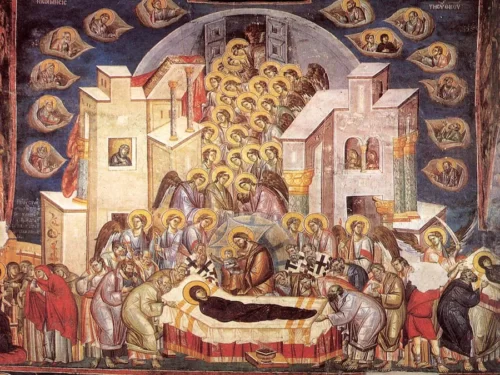On the 15th of August the Western Church celebrates its belief that ‘the Immaculate Mother of God, the ever Virgin Mary, having completed the course of her earthly life, was assumed body and soul into heavenly glory.’
Amongst other issues here, there is no mention of that very uncomfortable reality called death. In these terms it is often tempting to arrive at an image of Mary ascending to heaven in clouds of glory surrounded by angels, sometimes with apostles standing surprised or dismayed on the ground below. Baroque artists loved the idea. Their representations range from lovely to spectacular, but the whole is really irrelevant to our experience. The figures are a long way from the grounded reality of the Gospels or of Acts.


Baroque Assumption Images: Chartres Cathedral, France and Iglesia de San Bartolome, Seville
By contrast the Eastern Church celebrates, with great solemnity, the day as The Dormition. The Falling Asleep. Paul uses falling asleep and death interchangeably, so the word is no attempt to avoid the reality of Mary’s deathbed. Rather it imagines what must have been a transitional moment in that little close-knit group of men and women we call the early church. There were some who had known Jesus from the first days in Capernaum and the calling of fishermen, but only Mary knew him from infancy and his whole life down there in Nazareth. That was another world. She knew him in ways they could only imagine. In addition, her care had been consigned to them from the cross and it was a responsibility John and the rest were not going to take lightly. We have no idea when she died; it may have been decades after a last reference to her with the post-Ascension group at the beginning of Acts, but must have shattered them.
All sorts of traditions grew up in the Eastern Church, as early as the Fifth Century, affirming her centrality to the development of the early church. There are several apocrypha which recount the events of the Dormition and burial, and the tradition was fully embedded in the Eastern Church a century later. Thus, Mary lived in the house of John in Jerusalem, praying with the disciples and caring for that early tentative group. Then after some years the Angel Gabriel appeared to her again, this time to tell her that she had three days to live, and this time her joy was undiluted. Some traditions have her going to Bethlehem seven kilometres away to die, in others she remained in John’s house in the city.
The news spread like wildfire and miraculously the apostles were transported through the air to be with her: James from Spain, Peter from Rome, Bartholomew from Armenia, and so on – only Thomas missed out. Though her death was traditionally painless, the apostles gathered round her bier with the early fathers absorbed in grief. Mary was buried as she had asked, in Gethsemane. Then Thomas arrived in a cloud over her tomb three days later, he had been delayed getting away from India. There he met her body and asked her where she was going? She told him she was to join her son in Heaven, and gave him her girdle (her cincture) as proof of their meeting. Once again, Thomas joined the apostles belatedly, but this time it was his story to tell; they all went over to Gethsemane and found the tomb empty except for the most wonderful perfume.
Image: Dormition of the Most Holy Lady Theotokos
Much of this narrative is admitted as apocrypha but there is a concreteness to the narrative and an ongoing concern for Mary which the shape of the Gospels and Acts, as we have them now, lack. The existence of her tomb was testified by Juvenal, Bishop of Jerusalem, in 451. The material evidence for the existence of a tradition placing the tomb of Mary in Jerusalem is the Basilica erected above the sacred spot in Gethsemane, about the turn of the 4th and 5th centuries. It is now known as the Church of the Dormition.
Both the Eastern and Western Churches celebrate the feast on the same day. The Dormition centres on Mary in the early church and the grief at her death, and then on the empty tomb after three days which echoes the death of her son. Through Resurrection we have Assumption.
By contrast, the Western Church’s image is of unalloyed joy – of Mary triumphantly enthroned in glory as Queen of Heaven.
As an afterthought, the Cincture is, via Constantinople, now held in Mount Athos. In 2011, it was lent to the Resurrection Monastery in St Petersburg; about 200,000 people queued for two kilometres to see it – among the first to do so was Putin.
By Sandy Curnow





Comments
Faye Dennis
Thank you Sandy. What a wonderful reflection to read today - Feast of the Assumption
Mary Barbuto
Thanks Sandy, for your interesting and informative piece of writing.
David Rush
Great contribution Sandy Intellectual and so interesting
David Rush
Add Comment